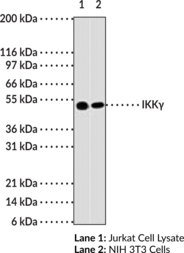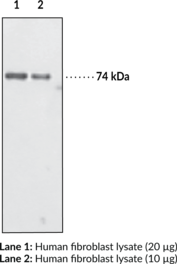Description
Nuclear Factor-κB (NF-κB) is sequestered in the cytoplasm by the IκB family of inhibitory proteins that mask the nuclear localization signal of NF-κB, thereby preventing translocation of NF-κB to the nucleus.{18540} External stimuli such as tumor necrosis factor or other cytokines result in phosphorylation and degradation of IκB, releasing NF-κB dimers. NF-κB dimers subsequently translocate to the nucleus and activate target genes. Synthesis of IκBα is autoregulated.{18541} IκB proteins are phosphorylated by IκB kinase complex consisting of at least three proteins, IKK1/α, IKK2/β, and IKK3/γ.{18542,18543,18544,18658,18545} IKKγ preferentially interacts with IKKβ and is required for activation of IKK complex. IKKγ is also known as NF-κB essential modulator (NEMO).{18545} The human T cell leukemia virus type I Tax oncoprotein that activates NF-κB binds neither to IKKα nor IKKβ, but complexes directly with IKKγ.{18659} This suggests that IKKγ may be a key molecule acting as an adapter for oncoprotein specific signaling to IKKα and IKKβ.{18659}
Synonyms: IKK3|NEMO|NF-κB Essential Modulator
Immunogen: His-tagged full length human IKKγ
Formulation: 100 µg of protein G-purified IgG
Isotype: IgG1
Applications: WB
Origin:
Stability: 180 days
Application|Western Blot||Product Type|Antibodies|Monoclonal Antibodies||Research Area|Cell Biology|Cell Signaling|NF-κB Signaling||Research Area|Epigenetics, Transcription, & Translation|Transcription Factors||Research Area|Immunology & Inflammation|Autoimmunity||Research Area|Immunology & Inflammation|Innate Immunity|Pattern Recognition||Research Area|Immunology & Inflammation|Innate Immunity|STING||Research Area|Infectious Disease




